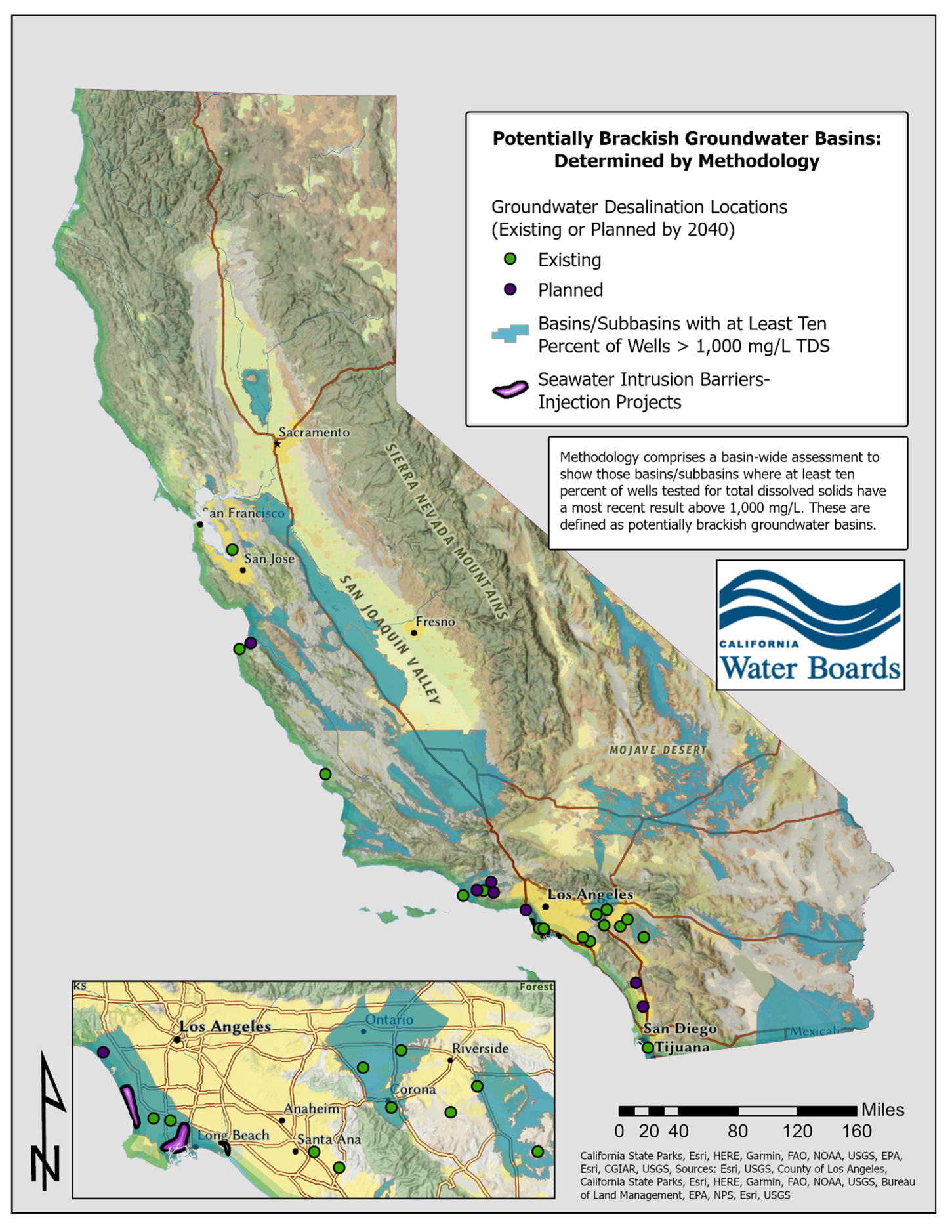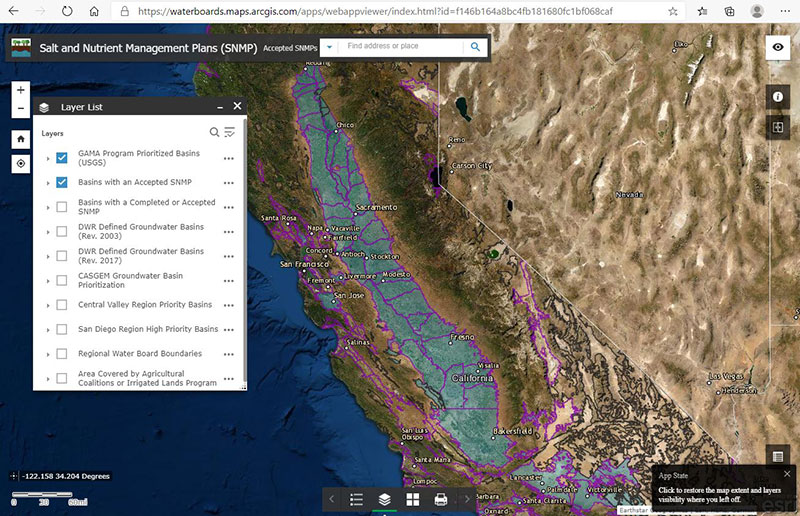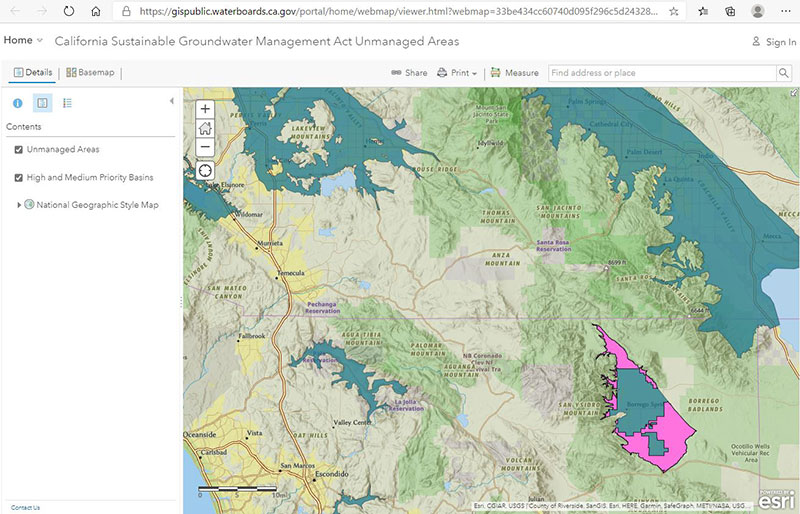
Salt and Nutrient Management Planning (SNMP)
Background
Salt and nutrient management planning is included in the Recycled Water Policy (Policy) to help address the potential for recycled water use to impact groundwater quality and to promote basin-wide management of salts and nutrients in groundwater.
- Some groundwater basins in the state contain salts and nutrients that exceed or threaten to exceed water quality objectives established in basin plans.
- Due to the varied sources of salts and nutrients in a groundwater basin, regulation of recycled water alone will not address these conditions,
- Not all basin plans include adequate implementation procedures for achieving or ensuring compliance with the water quality objectives for salt or nutrients; and
- The appropriate way to address salt and nutrient issues is through the development of regional or subregional SNMPs rather than through imposing requirements solely on individual recycled water projects.
Based on these findings, the Policy includes the intent that salts and nutrients from all sources be managed on a basin-wide or watershed-wide basis in a manner that ensures attainment of water quality objectives and protection of beneficial uses through development of SNMPs. The Policy states that SNMPs should be prepared by wastewater entities, together with salt- and nutrient-contributing stakeholders, in locally driven and controlled collaborative processes open to all stakeholders.
Once an SNMP is completed, stakeholders submit the final SNMP to the applicable regional water board for review. The regional water board must make a determination on acceptance of the SNMP via a board resolution within six months of receipt.
Furthermore, the Policy directs regional water boards to identify basins and subbasins within their region that are in need of salt and nutrient management planning to achieve water quality objectives by April 8, 2021. Every five years, regional water boards must additionally evaluate basin water quality to determine whether SNMPs are effectively addressing sources of salts and nutrients, whether additional sources of salts and nutrients may be impacting water quality that were not considered when the SNMP was developed, and whether SNMPs should be updated or revised based on observed trends, available assimilative capacity, and any identified data gaps.
Water Supply Strategy Deliverable:
Groundwater Basins with Potential for Brackish Groundwater Desalination
The Water Supply Strategy tasked the State Water Board with reviewing groundwater basins impaired by salts and nutrients and determining the volume of water available for brackish groundwater desalination. Staff reviewed available SNMPs and coordinated with the United States Geologic Survey to develop a map that identifies basins with potential for brackish groundwater desalination, as well as a short write-up that provides recommendations to further develop desalinated brackish groundwater as a water supply.
Salt and Nutrient Management Plans Webmap
Use the map tool to view the status of SNMP development in each groundwater basin in California. “Accepted SNMPs” are SNMPs that have been accepted by the Regional Board, typically through a Board resolution or letter from the Executive Officer. “Completed SNMPs” refer to SNMPs that have been submitted to the Regional Boards as final reports, but have not been formally accepted by that Board through a resolution or letter from the Executive Officer. Other information is available on the webtool, including basin identification, links to accepted SNMPs, location of the USGS-identified priority basins, and other spatial layers for reference.
Sustainable Groundwater Management Act (SGMA)
This interactive map identifies the location of unmanaged areas, pursuant to the Sustainable Groundwater Management Act (SGMA), as of September 28, 2018. An unmanaged area is a portion of a high- or medium-priority groundwater basin that is not within the management area of a groundwater sustainability agency (GSA), an adjudication, or an alternative sustainability plan. The deadline to establish a GSA was June 30, 2017. Anyone that extracts groundwater from an unmanaged area, with the exception of small domestic well users, must file a groundwater extraction report with the State Water Resources Control Board each year. Visit the SGMA Program page for more information.
Regional Water Quality Control
SNMP local contacts for Regional Water Quality Control Boards
| Regional Board | Contact | |
| Region 1 - North Coast | Chris Watt | Chris.Watt@waterboards.ca.gov |
| Region 2 - San Francisco Bay | Alec Naugle | Alec.Naugle@waterboards.ca.gov |
| Region 3 - Central Coast | Harvey Packard Matt Keeling |
Harvey.Packard@waterboards.ca.gov Matt.Keeling@waterboards.ca.gov |
| Region 4 - Los Angeles | Xiaofei Cui | Xiaofei.Cui@Waterboards.ca.gov |
| Region 5 - Central Valley | Angela Llaban | Angela.Llaban@waterboards.ca.gov |
| Region 6 - Lahontan | Jan Zimmerman Anna Garcia |
Jan.Zimmerman@waterboards.ca.gov Ann.Garcia@waterboards.ca.gov |
| Region 7 - Colorado River Basin | Jeffrey Fitzsimmons | Jeffrey.Fitzsimmons@waterboards.ca.gov |
| Region 8 - Santa Ana | Cindy Li | Cindy.Li@waterboards.ca.gov |
| Region 9 - San Diego | Sherrie Komeylyan | chehreh.komeylyan@waterboards.ca.gov |
Stay informed
Email Subscription Topic
Subscribe to our Recycled Water Policy email list to receive notifications and the latest updates. After subscribing, you will need to check your email host for a confirmation email to complete the subscription.
Contact Us
For questions or other recycled water inquiries, please contact:
- Division of Drinking Water’s Recycled Water Unit:
dwqrecylcedwater@waterboards.ca.gov
(Page last updated 10/16/2025)
Water is a precious resource in California, and maintaining its quality is of utmost importance to safeguard the health of the public and the environment.





